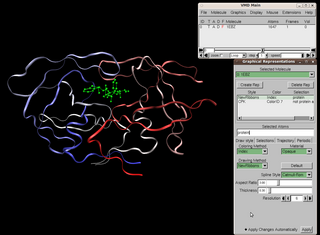Related Research Articles

In statistics, exploratory data analysis (EDA) is an approach of analyzing data sets to summarize their main characteristics, often using statistical graphics and other data visualization methods. A statistical model can be used or not, but primarily EDA is for seeing what the data can tell us beyond the formal modeling and thereby contrasts traditional hypothesis testing. Exploratory data analysis has been promoted by John Tukey since 1970 to encourage statisticians to explore the data, and possibly formulate hypotheses that could lead to new data collection and experiments. EDA is different from initial data analysis (IDA), which focuses more narrowly on checking assumptions required for model fitting and hypothesis testing, and handling missing values and making transformations of variables as needed. EDA encompasses IDA.

Visual Molecular Dynamics (VMD) is a molecular modelling and visualization computer program. VMD is developed mainly as a tool to view and analyze the results of molecular dynamics simulations. It also includes tools for working with volumetric data, sequence data, and arbitrary graphics objects. Molecular scenes can be exported to external rendering tools such as POV-Ray, RenderMan, Tachyon, Virtual Reality Modeling Language (VRML), and many others. Users can run their own Tcl and Python scripts within VMD as it includes embedded Tcl and Python interpreters. VMD runs on Unix, Apple Mac macOS, and Microsoft Windows. VMD is available to non-commercial users under a distribution-specific license which permits both use of the program and modification of its source code, at no charge.
Parallel rendering is the application of parallel programming to the computational domain of computer graphics. Rendering graphics can require massive computational resources for complex scenes that arise in scientific visualization, medical visualization, CAD applications, and virtual reality. Recent research has also suggested that parallel rendering can be applied to mobile gaming to decrease power consumption and increase graphical fidelity. Rendering is an embarrassingly parallel workload in multiple domains and thus has been the subject of much research.
JMP is a suite of computer programs for statistical analysis developed by JMP, a subsidiary of SAS Institute. It was launched in 1989 to take advantage of the graphical user interface introduced by the Macintosh operating systems. It has since been significantly rewritten and made available also for the Windows operating system. JMP is used in applications such as Machine Learning, Six Sigma, quality control, design of experiments, as well as for research in science, engineering, biotechnologies, and social sciences.
XLispStat is a statistical scientific package based on the XLISP language.

The Statistics Online Computational Resource (SOCR) is an online multi-institutional research and education organization. SOCR designs, validates and broadly shares a suite of online tools for statistical computing, and interactive materials for hands-on learning and teaching concepts in data science, statistical analysis and probability theory. The SOCR resources are platform agnostic based on HTML, XML and Java, and all materials, tools and services are freely available over the Internet.

Data and information visualization is the practice of designing and creating easy-to-communicate and easy-to-understand graphic or visual representations of a large amount of complex quantitative and qualitative data and information with the help of static, dynamic or interactive visual items. Typically based on data and information collected from a certain domain of expertise, these visualizations are intended for a broader audience to help them visually explore and discover, quickly understand, interpret and gain important insights into otherwise difficult-to-identify structures, relationships, correlations, local and global patterns, trends, variations, constancy, clusters, outliers and unusual groupings within data. When intended for the general public to convey a concise version of known, specific information in a clear and engaging manner, it is typically called information graphics.
GGobi is a free statistical software tool for interactive data visualization. GGobi allows extensive exploration of the data with Interactive dynamic graphics. It is also a tool for looking at multivariate data. R can be used in sync with GGobi. The GGobi software can be embedded as a library in other programs and program packages using an application programming interface (API) or as an add-on to existing languages and scripting environments, e.g., with the R command line or from a Perl or Python scripts. GGobi prides itself on its ability to link multiple graphs together.

Visual analytics is an outgrowth of the fields of information visualization and scientific visualization that focuses on analytical reasoning facilitated by interactive visual interfaces.

Michael Louis Friendly is an American-Canadian psychologist, Professor of Psychology at York University in Ontario, Canada, and director of its Statistical Consulting Service, especially known for his contributions to graphical methods for categorical and multivariate data, and on the history of data and information visualisation.

Leland Wilkinson was an American statistician and computer scientist at H2O.ai and Adjunct Professor of Computer Science at University of Illinois at Chicago. Wilkinson developed the SYSTAT statistical package in the early 1980s, sold it to SPSS in 1995, and worked at SPSS for 10 years recruiting and managing the visualization team. He left SPSS in 2008 and became Executive VP of SYSTAT Software Inc. in Chicago. He then served as the VP of Data Visualization at Skytree, Inc and VP of Statistics at Tableau Software before joining H2O.ai. His research focused on scientific visualization and statistical graphics. In these communities he was well known for his book The Grammar of Graphics, which was the foundation for the R package ggplot2.

A motion chart is a dynamic bubble chart which allows efficient and interactive exploration and visualization of longitudinal multivariate data. Motion charts provide mechanisms for mapping ordinal, nominal and quantitative variables onto time, 2D coordinate axes, size, colors, glyphs and appearance characteristics, which facilitate the interactive display of multidimensional and temporal data.

ggplot2 is an open-source data visualization package for the statistical programming language R. Created by Hadley Wickham in 2005, ggplot2 is an implementation of Leland Wilkinson's Grammar of Graphics—a general scheme for data visualization which breaks up graphs into semantic components such as scales and layers. ggplot2 can serve as a replacement for the base graphics in R and contains a number of defaults for web and print display of common scales. Since 2005, ggplot2 has grown in use to become one of the most popular R packages.

RStudio is an integrated development environment for R, a programming language for statistical computing and graphics. It is available in two formats: RStudio Desktop is a regular desktop application while RStudio Server runs on a remote server and allows accessing RStudio using a web browser. The RStudio IDE is a product of Posit PBC.

Hadley Alexander Wickham is a New Zealand statistician known for his work on open-source software for the R statistical programming environment. He is the chief scientist at Posit, PBC and an adjunct professor of statistics at the University of Auckland, Stanford University, and Rice University. His work includes the data visualisation system ggplot2 and the tidyverse, a collection of R packages for data science based on the concept of tidy data.
Yihui Xie is a Chinese statistician, data scientist and software engineer who formerly worked for RStudio. He is the principal author of the open-source software package Knitr for data analysis in the R programming language, and has also written the book Dynamic Documents with R and knitr.
Heike Hofmann is a statistician and Professor in the Department of Statistics at Iowa State University.
Deborah F. Swayne is an American statistician who worked for AT&T Labs and chaired the Section on Statistical Graphics of the American Statistical Association. She is known for her work as coauthor of GGobi, a software tool for interactive data visualization, and is president of the GGobi Foundation. She retired in 2016.
Andreas Buja is a Swiss statistician and professor of statistics. He is the Liem Sioe Liong/First Pacific Company professor in the Statistics department of The Wharton School at the University of Pennsylvania in Philadelphia, United States. Buja joined Center for Computational Mathematics (CCM) as a Senior Research Scientist in January 2020.
References
- 1 2 Dianne Cook publications indexed by Google Scholar
- 1 2 3 4 Dianne Cook at the Mathematics Genealogy Project
- ↑ Xie, Yihui (2013). Dynamic Graphics and Reporting for Statistics. iastate.edu (PhD thesis). Iowa State University. doi: 10.31274/etd-180810-3256 . OCLC 880379367. ProQuest 1500559149.
- 1 2 Q&A with Dianne Cook, Journal of Computational and Graphical Statistics Editor, American Statistical Association , retrieved 21 October 2017
- 1 2 3 Dianne Cook, Professor, Monash University, retrieved 21 October 2017
- ↑ "Dianne Cook", Emeritus Faculty, Iowa State University Department of Statistics, archived from the original on 20 October 2017, retrieved 21 October 2017
- ↑ Cook, Di. "Di Cook". dicook.org. Archived from the original on 25 June 2017. Retrieved 24 August 2020.
- ↑ Visiphilia: The love of plotting data (shared blog with Heike Hofmann)
- ↑ Buja, Andreas; Cook, Dianne; Swayne, Deborah F. (1996). "Interactive High-Dimensional Data Visualization". Journal of Computational and Graphical Statistics. 5 (1): 78–99. doi:10.1080/10618600.1996.10474696. ISSN 1061-8600.
- 1 2 3 4 Curriculum vitae (PDF), 2016, archived from the original (PDF) on 19 October 2016, retrieved 21 October 2017
- ↑ Reviews of Interactive and Dynamic Graphics for Data Analysis: John W. Emerson (November 2008), Biometrics 64 (4): 1301–1303, doi:10.1111/j.1541-0420.2008.01138_4.x, JSTOR 25502220; John H. Maindonald (December 2008), International Statistical Review 76 (3): 437–438, doi:10.1111/j.1751-5823.2008.00062_2.x; Eugenia Stoimenova (2009), Statistical Methods in Medical Research 18 (2): 223–224, doi:10.1177/0962280209104777; Pedro M. Valero-Mora (2009), Journal of Statistical Software 30, Book Review 7, doi:10.18637/jss.v030.b07.
- ↑ "Journal of Computational and Graphical Statistics". Taylor & Francis. Retrieved 6 March 2023.